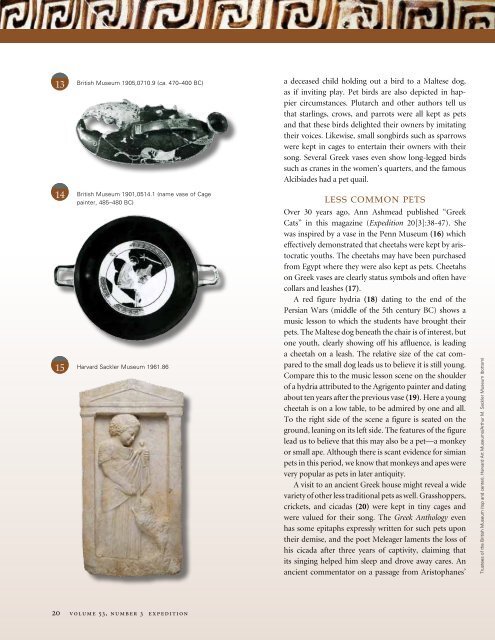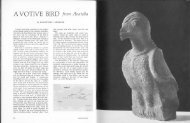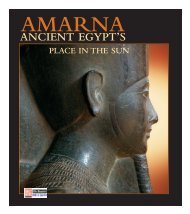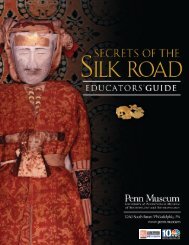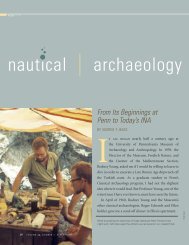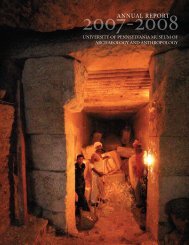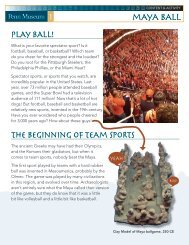Penelope's Geese - University of Pennsylvania Museum of ...
Penelope's Geese - University of Pennsylvania Museum of ...
Penelope's Geese - University of Pennsylvania Museum of ...
You also want an ePaper? Increase the reach of your titles
YUMPU automatically turns print PDFs into web optimized ePapers that Google loves.
13<br />
14<br />
15<br />
British <strong>Museum</strong> 1905,0710.9 (ca. 470–400 BC)<br />
British <strong>Museum</strong> 1901,0514.1 (name vase <strong>of</strong> Cage<br />
painter, 485–480 BC)<br />
Harvard Sackler <strong>Museum</strong> 1961.86<br />
20 volume 53, number 3 expedition<br />
a deceased child holding out a bird to a Maltese dog,<br />
as if inviting play. Pet birds are also depicted in happier<br />
circumstances. Plutarch and other authors tell us<br />
that starlings, crows, and parrots were all kept as pets<br />
and that these birds delighted their owners by imitating<br />
their voices. Likewise, small songbirds such as sparrows<br />
were kept in cages to entertain their owners with their<br />
song. Several Greek vases even show long-legged birds<br />
such as cranes in the women’s quarters, and the famous<br />
Alcibiades had a pet quail.<br />
less common pets<br />
Over 30 years ago, Ann Ashmead published “Greek<br />
Cats” in this magazine (Expedition 20[3]:38-47). She<br />
was inspired by a vase in the Penn <strong>Museum</strong> (16) which<br />
effectively demonstrated that cheetahs were kept by aristocratic<br />
youths. The cheetahs may have been purchased<br />
from Egypt where they were also kept as pets. Cheetahs<br />
on Greek vases are clearly status symbols and <strong>of</strong>ten have<br />
collars and leashes (17).<br />
A red figure hydria (18) dating to the end <strong>of</strong> the<br />
Persian Wars (middle <strong>of</strong> the 5th century BC) shows a<br />
music lesson to which the students have brought their<br />
pets. The Maltese dog beneath the chair is <strong>of</strong> interest, but<br />
one youth, clearly showing <strong>of</strong>f his affluence, is leading<br />
a cheetah on a leash. The relative size <strong>of</strong> the cat compared<br />
to the small dog leads us to believe it is still young.<br />
Compare this to the music lesson scene on the shoulder<br />
<strong>of</strong> a hydria attributed to the Agrigento painter and dating<br />
about ten years after the previous vase (19). Here a young<br />
cheetah is on a low table, to be admired by one and all.<br />
To the right side <strong>of</strong> the scene a figure is seated on the<br />
ground, leaning on its left side. The features <strong>of</strong> the figure<br />
lead us to believe that this may also be a pet—a monkey<br />
or small ape. Although there is scant evidence for simian<br />
pets in this period, we know that monkeys and apes were<br />
very popular as pets in later antiquity.<br />
A visit to an ancient Greek house might reveal a wide<br />
variety <strong>of</strong> other less traditional pets as well. Grasshoppers,<br />
crickets, and cicadas (20) were kept in tiny cages and<br />
were valued for their song. The Greek Anthology even<br />
has some epitaphs expressly written for such pets upon<br />
their demise, and the poet Meleager laments the loss <strong>of</strong><br />
his cicada after three years <strong>of</strong> captivity, claiming that<br />
its singing helped him sleep and drove away cares. An<br />
ancient commentator on a passage from Aristophanes’<br />
Trustees <strong>of</strong> the British <strong>Museum</strong> (top and center), Harvard Art <strong>Museum</strong>s/Arthur M. Sackler <strong>Museum</strong> (bottom)


